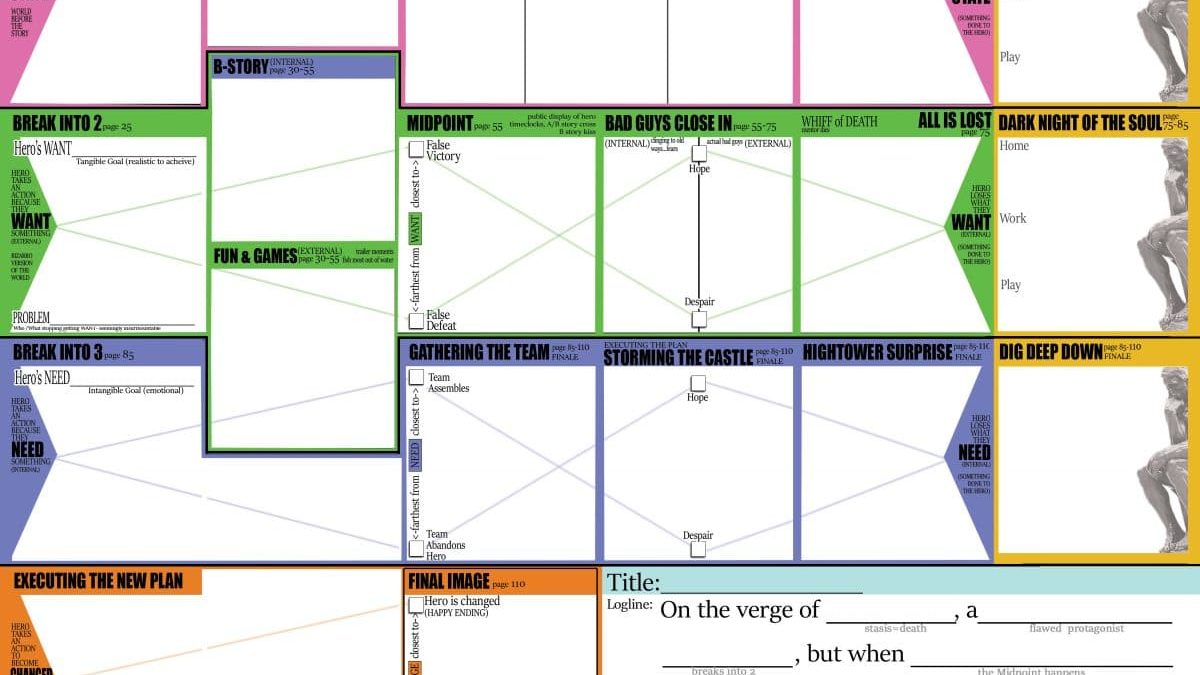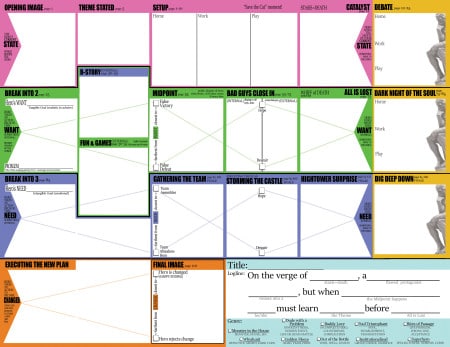Master Cat! Jose Silerio writes about an exciting, different, and downloadable format for the Blake Snyder Beat Sheet from workshop attendee and writer Tom Gowen:
Our workshops are a great opportunity to vet your ideas and put them through the wringer — or as we call it: The Blake Snyder Beat Sheet (or BS2). It’s always an interesting mix of seasoned writers and first-timers who walk in Saturday morning, a bit skeptical of their stories and unsure if the people seated in the room “will get it.” It doesn’t really matter how many scripts you’ve written in the past because when we start on a project, we’re all starting from the same place — a blank piece of paper (which really means an empty white screen in today’s vernacular).
This is where the BS2 really comes in handy, though we often forget that the BS2 is a document that grows and evolves as we discover more about our stories, its world, and the characters that inhabit it. There’s no need to overload it with details (you can do that in The Board). “Keep it simple” is our battlecry.
All we want with a BS2 is a clear straight story spine. We want to know (1) whose story it is, (2) what he (or she) wants, and (3) what’s stopping him from getting what he wants. But don’t forget that the BS2 isn’t just about knowing what the hero wants. It’s also about giving him what he needs because what we look for, in the end, is transformation… how our hero has grown and changed in the course of this story.
As we go through stories in a workshop and beats are thrown in and out, it becomes clearer how connected and intertwined all the 15 beats are to one another — because the goal is to give your audience a story that’s emotionally satisfying. It’s a one-two punch of wants and needs. External and internal.
In our last workshop, Tom Gowen had this “a-ha” moment in his story, but he took it even one step further. He designed a new beat sheet that clearly shows how the beats are connected. Instead of the simple numerically arranged listing of the 15 beats, he arranged them in such a way that shows how the beats affect and mirror one another — all in one nifty looking sheet. He even incorporated the Five Point Storming the Castle Finale in it. And did I say it’s color-coded as well?
Talk about a growing and evolving beat sheet! Tom hasn’t simply given the BS2 a facelift (which is sooooo Hollywood), he’s made it his own. He’s recreated it to “make it work,” not just for the story he was working on during the weekend, but for all the stories he will be writing in years to come. Thanks, Tom for sharing it with us.
What Tom did also reminded me of what the beat sheet can be. As Blake once said, “Learn the rules, then break the rules.” Yes, he wasn’t the first one who said this line, but Blake knew that his beat sheet could be much more than what he intended it for.
While the BS2 helps you shape and sculpt your stories, don’t forget you can also reshape and resculpt the BS2 to help you write stories you want to tell in your own unique way. The beat sheet is meant to be flexible and malleable. It’s not set in stone. It’s not the only way to tell a story. But it helps give your audience a way of following a story that will resonate with them.
Just ask the marketing executives, songwriters, and even lawyers and real estate agents who have told us how they’ve used Blake’s beat sheet for their own purposes. So next time you pull out your handy-dandy beat sheet, give Tom’s a spin. Or maybe you already have your own take on the beat sheet. Let the beat sheet serve you and your story. Work it and rework it. How can you keep it familiar enough but still give it a fresh take? Same but different, right?
Do you have your own reworked beat sheet that you want to share? Let us know. And if you have thoughts for Tom on how to further improve his one-sheet beat sheet, we look forward to your comments below.
Download the pdf of the Tom Gowen Blake Snyder Beat Sheet.
BJ Markel
26 Comments
Leave a Reply Cancel reply
You must be logged in to post a comment.











thanks Tom… a great evaluation of BS2…
Wow! This is amazing. I am excited to begin using it. I have been teaching my students about how to use the BS2 to aid their reading comprehension, and this is just one more tool for them. Thanks for sharing it!
Tom created something very useful and gave it away for FREE!!!
What’s this world coming to…;-)
Wow, this beat sheet is really good!! The only thing I am a little confused with is the lines in Act Two and Three; how can I use them in my stories?
The “lines” represent up or down beats that happen throughout the story. Blake wrote that at Midpoint if your hero has a False Victory, somewhere before All Is Lost he should have a False Defeat, or vise versa. I expanded that theory to show that these ups and downs happen throughout act 2 and act 3 and you can use them to help flesh out beats quickly. Thanks for all the support.
Thanks for sharing, Tom. Well done!
Thanks for sharing, Tom! This is an invaluable tool that only enhances Blake’s Beat Sheet. I’ll bet he’s smiling right now. :)
Can you explain “home / work / play?” Thanks.
In Blake’s third book, STRIKES BACK, beginning on page 31, he suggests breaking out the Set-Up (where you introduce the hero and his world) into 3 settings: the hero at home… at play… and at work. So your Set-Up card could break out into 3 actual scenes. While Home, Work, and Play won’t apply to every story, it’s still a way to think about setting up your hero’s world (and what needs fixing).
LOVE it!!! I was just getting into a bubble bath (my favorite thinking spot) with a clipboard and a bunch of BS2’s to map out some scenes when I saw this post. I find that my writing improves–and goes much faster–when I use the BS2 to structure scenes. I don’t always hit every beat when I’m writing out scenes–I probably could if I tried harder–but it really, REALLY helps me get the basics down. It also helps me discover new ways to approach the scene. I get a fresh angle on it just by considering each beat.
So I wouldn’t say my beat sheet is a reworking of Blake’s, but I enjoy using it for something other than fleshing out the entire story. It’s an awesome scene booster!
I’m printing out this new BS2. Thanks, Tom. Hope the colors won’t run. If Blake were here, he’d tell me how tough it is to be a working writer. Dreaming up stories in the bathtub and getting paid for it–what hardship!!!
TGIF, everyone~
:-)
Can you put this beatsheet to work. Show some example or a breakdown. I know your going to say to read the book, but it’s always seems Blakes beats need to be explain. I would love to see some examples on this beatsheet.
This looks like a wonderful tool for story analysis – not so much a Beat Sheet, as a “Beat Analysis Chart.” The more I study it, the more I like it, especially the lines. I can’t wait to take it for a test drive. Thanks!
This looks fab, Tom! I can’t wait to use it on my next project. :-)
Wow! Thanks so much for sharing this. I had a few ah-ha moments while going through the new sheet! Very exciting.
Very, very good reading grid of BS2! I’m going to use it, of course! Congratulations Tom!
Thanks for sharing this! I love that you include the logline prompts. Very useful!
Thank you great stuff
Tom,
This is a brilliant tool. Well done. Blake would be proud. I already used it for a GF idea I’ve had for the last couple of months. It helped me conceptualize the story much better than the old BS2 template.
Best,
Victor
This is great! I would love to see Fun and Games expanded into flip flopping back and forth between A and B story as well as these helpful F&G beats:
The World Through Rose Colored Glasses
This describes the world the protagonist has now entered, one he likes a lot. A new group of friends, a seeming end to the sharp pangs from the Shard of Glass. Think in Spiderman 2 (hope this is the right movie) when Peter Parker has to wear eyeglasses, and likes it. He sees the cops running past on some emergency, and he just eats his ice cream cone.
All My Rowdy Friends
The protagonist begins nesting with a mentor or new buddies. Exciting to join a new group of people, who don’t judge him by the Shard of Glass or any other flaws. Different than the Rose Colored Glasses because this focuses on the new relationships. Luke Skywalker befriends Obi-Wan and he doesn’t treat him as a space-hick.
The Car Chase
At some point the Bad Guys have to make some type of appearance in the Fun and Games. When they do, it usually involves them wanting something the protagonist possesses. They give chase, which propels us toward the Mid-Point and a False Victory/Defeat. Rocky and Apollo Creed meet in a press conference, and Creed puts the fear into Rocky. Amps up the Debate, re-inforces the theme and the protagonists flaws.
I love this. Simple and easy to follow, plus the bright colors make the creative part of me happy. :) Thanks!
I’m going on episodes and noticed the page count on BS2. Curious is there a work around on this?
Thanks
To the Save the Cat Team: Will the next Save the Cat software adopt this look/groupings into the user interface? Please, please, please do!
Yes Michael!! I find that would be a very good idea! A great evolution of the Beat Sheet for the software!
wow. great work!
i only have one thing: the”fun&games” space is really small – maybe too small?
Fantastic Tom
super useful! Thank you!! Jose and BJ… ya’ll rock!! and Tom and his aha! moment…what an awesome inspiration to share!!!